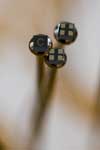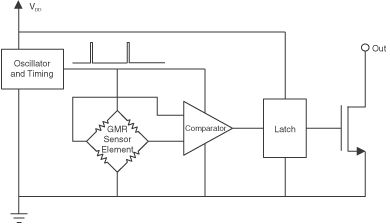 |
In This Issue |
 |

 |
Quick Links |
 |

 |
Recent Accolades |
 |
|
The ADL-Series ULLGA sensor (see product overview at right) was named the April Product of the Month by the German trade magazine Konstruktion & Engineering.
For the first time, NVE was ranked in the Star Tribune annual list of the largest Minnesota-based publicly-traded companies.
Constant Contact named NVE an e-mail Marketing All Star, citing engaging content and high readership rates.
<Links to Accolades> |
|
|

 |
In the News |
 |
|
The new IL41050 Isolated
CAN Transceiver was covered in Electronic Specifier
and Elektronik Informationen. The IL41050 reduces chip count and improves performance compared to discrete transceivers and optocouplers.
<Links to Isolator News> |
|
|

 |
Transition Metals |
 |
|
What did the cowboy do with his horse?
Rhodium
What did the gambler do with his cards?
Palladium |
|
|

 |
Voicemail Playlist |
 |
|
Currently playing on our phone system background music is the theme from
“Chips,” the ’70s TV show.
NVE is a leader in sensor and isolator chips. |
|
|

 |
Memorial Day |
 |
|
NVE will be closed for business Monday, May 31 in observance of Memorial Day. |
|
|
 |
|
| Featured Product |
|
Ultraminiature Magnetic Sensors
|
 |
| ADL-Series Sensors fit |
| on the head of a pin. |
| |
Smaller than the head of a pin, the award-winning 1.1 mm x 1.1 mm x 0.45 mm ADL-Series GMR
Digital Switches are NVE’s smallest packaged parts
Ideal for ultraminiature industrial controls, outputs are configured as magnetic “switches,” where the output turns on when a magnetic field
is applied and off when the field is removed.
The devices are omnipolar, meaning the field can be either polarity, and the magnetic operate point is extremely stable
over supply voltage and temperature.
Continuously-operating versions consume about 200 microwatts.
Internally duty cycled versions consume less than a microwatt; ideal for battery-powered devices such as meters and portable instruments.
 ADLxxx-14 Functional Block Diagram
ADLxxx-14 Functional Block Diagram
Key ADL-Series specifications are:
• 1.1 mm x 1.1 mm x 0.45 mm ULLGA package
• 2.4 - 3.6 V supply voltage
• As low as 72 nW typ. power consumption at 2.4 V
• 20, 28, or 40 Oersted operate points
• Current-sinking output up to 100 µA
• -40°C to +125°C temperature range
Because of the large number of permutations, not all part numbers are
available off the shelf, so call our Sensor department at (800) GMR-7141 or e-mail sensor-info@nve.com for information or samples. You can see them (bring your magnifier) at Sensor+Test 2010 (below).
<Data Sheet for NVE’s Smallest Packaged Sensors (.pdf)>
|
| Exhibitions |
|
Sensor+Test 2010
 NVE sensors will be on display at Sensor+Test 2010 in cooperation with NVE distributor HY-LINE Sensor-Tech. The show runs May 18 to May 20 in Nüremberg, Germany, and is one of the largest sensor shows in the world. NVE sensors will be on display at Sensor+Test 2010 in cooperation with NVE distributor HY-LINE Sensor-Tech. The show runs May 18 to May 20 in Nüremberg, Germany, and is one of the largest sensor shows in the world.
<Free Registration Courtesy of HY-LINE>
|
| Application Corner |
|
Remembering Magnets
By “Magnetic” Jay Brown
Vice President, Sensors
Sometimes forgotten in sensor systems are the humble magnets. But the right magnet can make a big difference in sensor system performance, often without much cost impact. NVE stocks several popular magnet types.
Magnet Configurations
Magnets can be often used to activate a magnetic sensor, as with a simple proximity sensor, or to bias a sensor where the field is deflected in proximity to ferromagnetic material. For example, GMR Switch Sensors are often activated with a magnet and GT Gear-Tooth Sensors are usually operated with a bias magnet.
Material Grades
Ceramic and Alnico magnetic materials are graded between one and eight. Grade 1 materials are non-oriented or isotropic. In general, higher grades are more fully oriented (anisotropic) and have higher field strengths. Magnet cost also tends to increase with material grade.
Materials
Ceramic (ferrite) magnets are made of strontium carbonate and iron oxide.
Grade 1 have the weakest magnetic field strengths, grade 5 are inexpensive and popular with our customers, and grade 8 have good field characteristics for sensor systems and are still relatively inexpensive.
Alnico refers to aluminium-nickel-cobalt alloys. Alnico magnets have working temperatures above 1,000°F (538°C). Alnico grade 8 magnets provide a very stable field over wide temperature ranges, making them the preferred choice for high temperature application.
Rare-earth magnets (samarium-cobalt or neodymium-iron-boron) are relatively expensive and have very high field strengths. The high field strengths are generally not necessary in NVE sensor systems and may saturate sensor, resulting in no output.
Sizes and Shapes
There are almost infinite choices of magnet sizes and shapes. Some of the more common among our customers are bar magnets around 1/2 inch long and disk magnets from 1/8 to 1/4 inch in diameter.
Specialty Magnets

Split-pole magnet
|
Split-pole disk magnets are typically used for
angle sensors such as AAT001 Angle Sensors, although a bar magnet can also be used. Split-pole magnets have poles on opposite sides of the diameter rather than top and bottom as with a conventional disk magnet (see figure at right).
Ring magnets have multiple poles around the diameter and can be used for rotational or course-angle sensing. Ring magnets are common in ABS systems, for example, and can be used with GT Sensors.
<Magnet Data Sheet (.pdf)>

|
|
|

